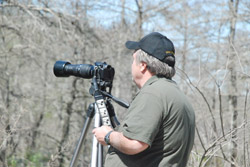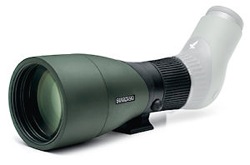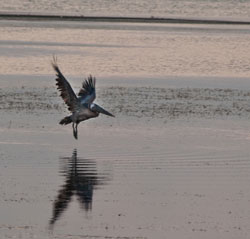Spotting Scopes
Why Choose a Spotting Scope
 At a magnification of 7x to 10x, binoculars are fine for birds that are close up or large birds that are a moderate distance away. For greater magnification,
birders turn to spotting scopes - telescopes designed for birding. Most of the design factors are the same for scopes and binoculars, and have been discussed
in previous articles, so here we'll cover the design, use, and buying considerations that are unique to scopes.
At a magnification of 7x to 10x, binoculars are fine for birds that are close up or large birds that are a moderate distance away. For greater magnification,
birders turn to spotting scopes - telescopes designed for birding. Most of the design factors are the same for scopes and binoculars, and have been discussed
in previous articles, so here we'll cover the design, use, and buying considerations that are unique to scopes.
Birding scope magnifications range from 10x to 75x. The higher the power, the more any design defects are increased, so very high power requires the highest
glass quality and the largest objective lenses. Otherwise, these high powers are essentially useless.
Scopes range in price from about $250 to almost $2,000 just for the bodies. As with most optics, weigh the cost against the benefits, then get the best you
can afford. However, when buying a scope, you also need to set aside enough money for a tripod that will properly support the quality of your scope. For a
complete discussion, see our section on tripods and other support systems.
No discussion of birding scopes today is complete without a mention of digiscoping - the technique of taking photos with a digital camera through a spotting
scope. If you think you will want to do it on a regular basis, read our digiscoping page for more things to consider before
buying your scope.
Construction
 Several design factors distinguish scopes from binoculars, other than the obvious that scopes are monocular. To accommodate higher magnification, objective
lenses are larger and barrels are longer
Several design factors distinguish scopes from binoculars, other than the obvious that scopes are monocular. To accommodate higher magnification, objective
lenses are larger and barrels are longer
There are several features common to most birding scopes. Most have interchangeable eyepieces (specific to manufacturer and line),
allowing you to choose one (or more) that fits your preferences. All birding scopes have a mounting plate that facilitates attachment to a tripod or other
support device. Most have a sight to help line up the bird before looking through the eyepiece.
There are two basic body designs. With straight scopes, the barrel and the eyepiece have axes that are parallel, if not coincident. Angled scopes bend the
light path so that the eyepiece is 45º from the barrel axis. The benefits and drawbacks of each design are discussed below.
Telescope designs fall into one of three categories: refractor, catadioptric, and reflector.
Refractor
Refracting telescopes use a lens as the objective at one end of a tube, an eyepiece at the opposite end of the tube, and an internal prism to lengthen the
optical path and right the image. Nearly all birding scopes on the market today are refractors.
Catadioptric
 Catadioptric telescopes are a hybrid or compromise design between reflectors and refractors. These scopes use both a lens and a mirror. The Schmidt-Cassegrain
is a catadioptric design in which a lens at the front of a short tube directs the image on a concave mirror at the other end. (Technically, the lens does not
focus the image; it merely corrects for aberrations in the mirror design). This mirror focuses the image forward onto small concave mirror located towards the
front of the tube. This second mirror then focuses the image back through a hole in the center of the back mirror and into the eyepiece. Most catadioptric
scopes have images that are vertically correct, but reverse the image left and right. This can be confusing when trying to follow a moving bird, especially
for inexperienced users. The benefit of catadioptric scopes is that they provide greater magnification than refracting scopes of the same weight.
Catadioptric telescopes are a hybrid or compromise design between reflectors and refractors. These scopes use both a lens and a mirror. The Schmidt-Cassegrain
is a catadioptric design in which a lens at the front of a short tube directs the image on a concave mirror at the other end. (Technically, the lens does not
focus the image; it merely corrects for aberrations in the mirror design). This mirror focuses the image forward onto small concave mirror located towards the
front of the tube. This second mirror then focuses the image back through a hole in the center of the back mirror and into the eyepiece. Most catadioptric
scopes have images that are vertically correct, but reverse the image left and right. This can be confusing when trying to follow a moving bird, especially
for inexperienced users. The benefit of catadioptric scopes is that they provide greater magnification than refracting scopes of the same weight.
Reflector
Reflecting telescopes use a mirror as the objective. The simplest way of explaining this is by illustrating a Newtonian reflector. In this scope, light enters
one end of a long tube and strikes a concave mirror at the back of the tube. This mirror focuses the image forward onto a small flat mirror near the front of
the tube. This mirror diverts the out the side of the tube and through the eyepiece. We know of no current birding telescopes of this design, although a field
portable model was marketed recently with little success.
Objective Lenses
Objective lenses range in size from 50-100mm. As noted in the binocular sections, larger objectives gather more light but weigh more. Since exit pupil,
a factor of image brightness, is defined as objective size divided by magnification, large objectives are essential for high magnification. In general,
exit pupils less than 1.33mm are insufficient for top performance in adverse conditions.
The other main factor of image brightness is light transmission. To increase light transmission, manufacturers use special glass and coatings on lenses and
prisms to reduce reflections. Some designations used to label special glass are "Fluorite","ED" for extra-low dispersion, "HD"
for high density, and APO for apochromatic. Many top end birding scope designs offer models either with or without the expensive glass. In most conditions,
you will not notice the difference between the lower and higher priced glass. However, when conditions get tough - when the light levels get low or overcast
creates low contrast - the expensive glass earns its keep.
Eyepieces
 Most scope makers offer a variety of eyepieces for their scopes. Often, you will have to choose and pay for your eyepiece separately. Some manufacturers
design their eyepieces so they will work on multiple scope lines. Others have eyepieces designed specifically for each line. Eyepieces designed to fit both
80mm scopes and 65mm scopes may have lower magnifications on the smaller objective scopes.
Most scope makers offer a variety of eyepieces for their scopes. Often, you will have to choose and pay for your eyepiece separately. Some manufacturers
design their eyepieces so they will work on multiple scope lines. Others have eyepieces designed specifically for each line. Eyepieces designed to fit both
80mm scopes and 65mm scopes may have lower magnifications on the smaller objective scopes.
Until the last few years, zoom eyepieces were considered inferior to those with fixed magnification. While zooms now rival fixed power eyepieces in sharpness
and brightness, the fixed lenses are still useful tools. Common magnifications are 15x, 20x, 22x, 27x, 30x-32x, and 50x. The 30x and 50x eyepieces often come
in wide-angle designs that are excellent for activities like sea watching. Other fixed eyepieces (usually 27x) feature long eye relief, which is very useful
for eyeglass wearers and for digiscoping.
Angled or Straight
One of the most fervid debates among birders is whether to use a straight or angled scope. Each side has its staunch supporters, as well as its pros and cons.
Again, it all comes down to how you want to use your scope. Here are the benefits of each:
Angled
- Easier to share with a group
- Higher eye point means you can use a shorter tripod
- Better for birds soaring or in tall trees
Straight
- Less strain on your neck for level viewing
- Less chance of eyepiece collecting rain or dust
- Easier for viewing birds on the ground or water or below a cliff
- Easier to aim when inexperienced
Focusing
There are three different designs used for the focusing mechanism in scopes.
The most popular design is a worm gear system driven by a single small knob on the side or top of the scope. This system is fairly fast focusing but a bit
harder to focus finely. Manufacturers who use this system include Bausch & Lomb, Bushnell, Fuji, Kowa, Pentax, Swift, and Zeiss.
The next system is a helical gear driven by a ring around the body of the scope. This is a bit slower on coarse focus but has better fine focus control.
Nikon and Swarovski use this system.
Perhaps the best of both worlds is the system used by Leica. It uses a worm gear with two drive knobs on the same axis with different numbers of teeth on
their drive gears. Both knobs always rotate when focusing, but one knob will give fast coarse focus while the other gives good fine focus.
Conclusions
- Scopes offer a closer view than binoculars.
- Scopes range widely in capability and price.
- Higher magnification requires larger objectives for best results.
- Eyepieces come separately and a zoom is not always the best choice.
- Angled and straight scopes both have their benefits.
- Focusing systems vary in speed and accuracy.
- Leave money in your budget for getting the proper tripod.
Previous Article - Basics IV | Next Article - Tripods